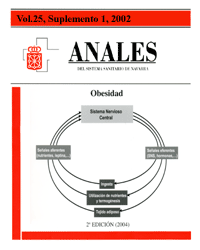Obesity: concept, classification and diagnosis
DOI:
https://doi.org/10.23938/ASSN.0810Keywords:
Obesidad. Índice de Masa Corporal. Clasificación.Abstract
Obesity is a chronic disease that is characterised by an increase of fat mass and as a result by an increase in weight. There is therefore an increase in the energy reserves of the organism in the form of fat. The term chronic is applied due to its forming part of the group of diseases that we are unable to cure with the therapeutic arsenal that is now available. From an anthropometric point of view, which is habitually used in the clinic, a person is considered to be obese with a Body Mass Index equal to or higher than 30 kg/m2. To be able to evaluate obesity account must be taken not only of the anthropometric aspects but also of the possible genetic factors; the causes of the disease must be studied and the possible existence of associated complications and diseases must be checked. Treatment must always be personalised and adapted to the characteristics and comorbidities presented by the patient. The dominant criteria favourable to therapeutic intervention in obesity are especially based on the demonstration that with a moderate loss of body weight (5-10 %) a notable improvement can be obtained in the comorbidity associated with obesity and in the quality of life of the obese patient.Downloads
Downloads
Published
How to Cite
Issue
Section
License
La revista Anales del Sistema Sanitario de Navarra es publicada por el Departamento de Salud del Gobierno de Navarra (España), quien conserva los derechos patrimoniales (copyright ) sobre el artículo publicado y favorece y permite la difusión del mismo bajo licencia Creative Commons Reconocimiento-CompartirIgual 4.0 Internacional (CC BY-SA 4.0). Esta licencia permite copiar, usar, difundir, transmitir y exponer públicamente el artículo, siempre que siempre que se cite la autoría y la publicación inicial en Anales del Sistema Sanitario de Navarra, y se distinga la existencia de esta licencia de uso.








